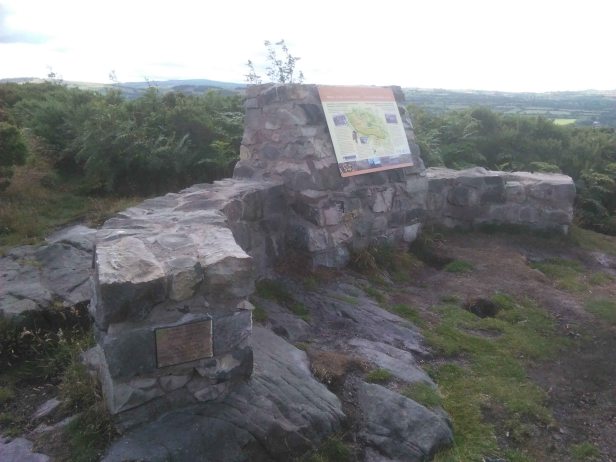
Overlooking Hope and Caergwrle, Flintshire, is Hope Mountain/Waun y Llyn. Like many, I live under the shadow of Hope Mountain. It is a distinctive bell-shaped ridge as seen from the Cheshire plain and surroundings to its east, yet set apart from the higher hills to its south-west, west and north-west.
From Hope Mountain one can see almost everything there is to see in NW England and NE Wales: the Clwydian range, Halkyn Mountain, the Dee estuary, Hilbre Island and the Wirral, Liverpool, Runcorn, Chester, the Mid Cheshire Ridge including Beeston Castle and all the way down to the Shropshire plain.
The only thing out of sight is Wrexham…
It is an important landmark, not so much for its height as its distinctiveness in shape and the specific range of views it offers anyone climbing it.

The mountain was historically used for quarrying of sandstone for glass manufacture. To my knowledge, there is little archaeological evidence for earlier activity apart from some later prehistoric flints from Horeb on its eastern slope.
I have a particular interest in this hill because it sits between Wat’s Dyke to its east and the northernmost stretch of Offa’s Dyke to its west. I regard this hill as very significant in relation to the linear earthworks, my preliminary ideas about which I discuss here. I have also discussed the early medieval significance of Hope to its east and Caergwrle in previous posts. More on this in my future research!
I went up once in bad weather a couple of times when I first moved to the area in 2008/2009, but I confess I only ventured up there recently because of a range of practical issues regarding the demographics and personalities of my kids and their behaviour on hills and around dogs. Anyway, recently I went up with all five offspring and mother-in-law. We enjoyed the views, we enjoyed the sandstone surfaces, heather and gorse and we also encountered some archaeodeath wonders. I make no claim that these elements coalesce into anything significant. I report them here simply because they were there…


The Discovery of Offa’s Pipe
Within sight of the line of Offa’s Dyke to the west and Wat’s Dyke to the east, I had every expectation of uncovering evidence of Mercian occupation. My kids found an extremely ancient linear feature revealed by the worn footpath: blue and cylindrical, it could only be one thing: Offa’s Pipe!

Memory and Panorama
Elsewhere I have discussed the key modern memorial significance of views enjoyed by both the living and the dead in selecting where the dead are commemorated. Another archaeodeath dimension on Hope Mountain is a family memorial plaque situated upon the end of the curving stone structure that marks the northermost viewpoint on the mountain and contains one of two heritage boards with details of the distinctive natural and heritage dimensions of the hill.

The Memory Tree
Every hill seems to have a memorial tree; usually windspread and iconic, set apart and yet accessible. We also found one of these during our walk over Hope Mountain. It was a hawthorn and holly tree intermingled; a distinctive local landmark on the hill that seems to have attracted memorial and/or votive offerings in the form of shoelaces and ribbons tied to its branches.


Cow Wars!
Hope Mountain seems to be a favourite spot for dog walkers. Yet dogs off leads can worry sheep and cattle. A sign set up by Flintshire County Council warns dog walkers to keep their animals under control. An angry dog walker has clearly taken to the heritage sign and vandalised it in defiance. Fascinating and freaky.




